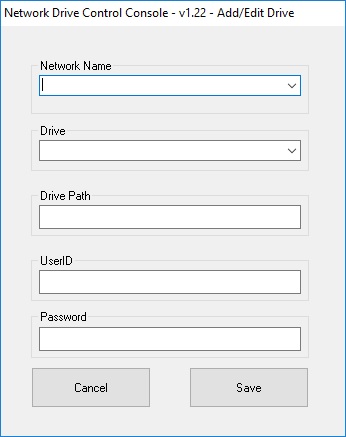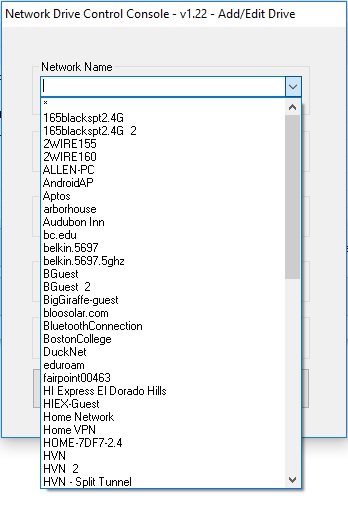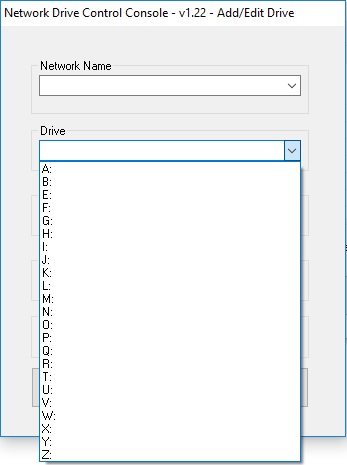Clone + Edit Drive
To clone (duplicate) an existing drive with the option to edit it, select the row represented by the drive you wish to clone and press the Clone + Edit Drive button, or right click & select Clone + Edit.
The drive will be duplicated, added to the end of the drive list. In addition, a dialog like that below should appear, except it will be filled out with the cloned drive information. If you don't want to change anything, hit Cancel and the cloned drive will be an exact duplicate of the original. If you made it by mistake, you can simply delete it.

If you want to change the Network Name, type in the Network Name that you want NDC to look for and mount the drive when it finds it. Windows pretty much keeps a record of every network, including wireless networks, to which it has ever successfully connected. Those are listed in the drop down list as shown below, and can be selected in place of typing in the name. You are not restricted to networks listed. If the network you want associated with the mapped drive is not listed, you can manually type it into the box. In addition, you can wildcard the network name by selecting "*", which should appear at the top of the list.

Either type in the drive letter you want the drive mapped to, or select a drive from the drop down list as illustrated below. The drop down list automatically excludes drive letters used by the PC for internal hard drives, optical drives, or drive letters already used for the network you have selected.You are not restricted to the listed drive letters. If you want to use a drive not on the list, you can enter it by typing it in. Later checks performed when you hit save may restrict your allowed selection.

If you want to change the path to the server, type in the full path to the server and directory that you want mapped into the Drive Path box, as well as the User ID and password credentials that the server will want to connect into their respective boxes. NDC will accept Drive Paths (server paths) in the form of \\server\directory or \\X.X.X.X\directory where X.X.X.X is the server IP Address, https://server/directory or http://server/directory or a local path on the PC (e.g. C:\Temp\Junk). It will interpret Drive Paths in the form of \\server\ directory or \\X.X.X.X\directory as drives to be mapped using regular Windows network protocols, Drive Paths in the forms of https://server/directory or http://server/directory as drives to be mapped using WebDAV protocols, and Drive Paths in the form of a local disk path as a local mapping of a directory onto a drive number, akin to the Command Line subst command. Please note that if server is on your internal network, you may need to modify the PC's host file to explicitly tell the PC what the internal IP Address of the server is.
I'll remind folks that if you don't like designating the IP address and would prefer a name, you can edit the Windows Host File to designate a name to be associated with a given IP address. That way, for example, you could refer to a NAS on your home network as "MyNAS" rather than as an IP address.
NDC supports regular Windows protocols, such as Server Message Block (SMB), Common Internet File System (CIFS), Netbios, as well as WebDAV. The security restrictions (i.e. whether a given machine allows the insecure http form of WebDAV) are determined by Windows defaults or Administrator imposed policies. For more information, please see Permissions, Encryption & Other Issues.
Fill out the User ID and password credentials. The password is visible while you type so you can verify that you entered it correctly. Then press Save. If you leave the User ID field blank, a message box will appear asking for you to confirm that you really did intend for the User ID to be blank. If you leave the password field blank, a message box will appear asking for you to confirm that you really did intend for the password to be blank. If you try to add a new mapping that assigns a drive letter & network name combination that is already in use (i.e. you clone the drive without changing the drive letter & network name combination), a message box will appear telling that is not allowed. (Conflicts created by wildcarding the network name will also be prevented.) If you intended to modify an existing drive letter & network name combination, use the edit function instead. The User ID and password credentials are not used when mapping a drive letter to a local directory.
